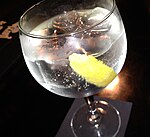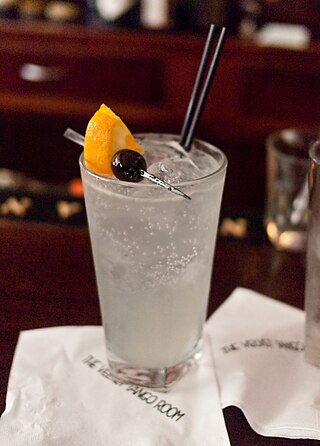
The Tom Collins is a Collins cocktail made from gin, lemon juice, sugar, and carbonated water. First memorialized in writing in 1876 by Jerry Thomas, "the father of American mixology", this "gin and sparkling lemonade" drink is typically served in a Collins glass over ice. A non-alcoholic "Collins mix" mixer is produced, enjoyed by some as a soft drink.

Grenadine is a commonly used nonalcoholic bar syrup characterized by its deep red color. It is a popular cocktail ingredient renowned for its flavor as well as its ability to give a reddish or pink tint to mixed drinks. Grenadine was traditionally made from pomegranate but is more often encountered as a syrup made from elder, blackcurrant, raspberry, gooseberry or other berries and fruits.

The Zombie is a Tiki cocktail made of fruit juices, liqueurs, and various rums. It first appeared in late 1934, invented by Donn Beach at his Hollywood Don the Beachcomber restaurant. It was popularized on the East coast soon afterwards at the 1939 New York World's Fair.
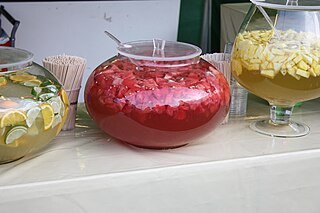
The term punch refers to a wide assortment of drinks, both non-alcoholic and alcoholic, generally containing fruits or fruit juice. The drink was introduced from the Indian subcontinent to England by employees of the East India Company in the late 17th century. Punch is usually served at parties in large, wide bowls, known as punch bowls.

Pat O'Brien's Bar is a bar located in New Orleans, Louisiana that began operation as a legal liquor establishment on December 3, 1933, at the intersection of Royal and St. Peter streets in the French Quarter. Before that, during Prohibition the bar was known as Mr. O'Brien's Club Tipperary; the password "storm's brewin'" was required to gain entrance to the establishment. In December 1942 it moved to its present location at 718 St. Peter Street, into a historic building dating from 1791. Pat O'Brien's is home to the original flaming fountain and the hurricane cocktail. There is also a piano bar, featuring twin "dueling" pianos where local entertainers take song requests. The dueling piano bar is thought to be the first of its kind.
Fassionola is a typically red-colored fruit-flavored syrup that was frequently used in tropical drinks during the 1930s but is now a relatively unusual ingredient. It also comes in green and gold varieties that are sometimes made to taste differently. It is used as a fruit punch concentrate, and some claim that a red-colored fruit syrup called fassionola was an ingredient in the original Hurricane cocktail. Although a frequent attribution, solid evidence of fassionola's use in the Hurricane from before 1956 is lacking, and it is not known what the precise ingredients were in the earliest version of fassionola.

A sour is a traditional family of mixed drinks. Sours belong to one of the old families of original cocktails and are described by Jerry Thomas in his 1862 book How to Mix Drinks.
A Scorpion Bowl is a communally shared alcoholic tiki drink served in a large ceramic bowl traditionally decorated with wahine or hula-girl island scenes and meant to be drunk through long straws. Bowl shapes and decorations can vary considerably. Starting off as a single-serve drink known as the Scorpion cocktail, its immense popularity as a bowl drink in tiki culture is attributed to Trader Vic.
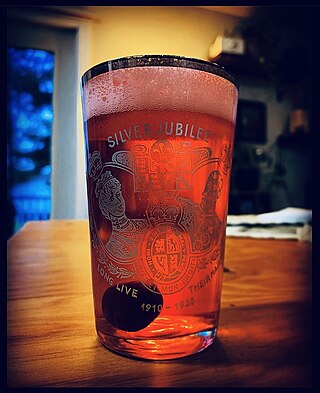
A beer cocktail is a cocktail that is made by mixing beer with other ingredients or another style of beer. In this type of cocktail, the primary ingredient is usually beer.

A flaming drink is a cocktail or other mixed drink that contains flammable, high-proof alcohol, which is ignited before consumption. The alcohol may be an integral part of the drink, or it may be floated as a thin layer across the top of the drink. The flames are mostly for dramatic flair. However, in combination with certain ingredients, the flavor of the drink is altered. Some flavors are enhanced, and the process may impart a toasted flavor to some drinks.

The Pimm's cup is a cocktail that is popular in England, in the United Kingdom. It is one of numerous fruit cups, a type of cocktail with gin, a soft drink, and fruit. Its primary spirit is Pimm's No. 1 Cup, a gin-based beverage flavored with fruits and spices invented around 1823 as a health drink.
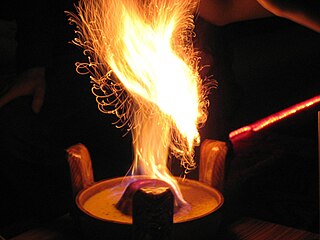
Flaming volcano is a large tropical group cocktail typically made with rum, brandy, pineapple juice, orange juice, and orgeat syrup. Many variations exist, and the cocktail in the 21st century is more about the presentation than an adherence to a set list of ingredients. It is usually a multi-user drink, served to a group in a special vessel known as a volcano bowl, which is a decorative ceramic bowl designed with a rising central hub feature resembling a volcanic cone. The cone includes a "crater" reservoir which can be partially filled with rum or another flammable liquor. The crater liquor is carefully ignited when serving, creating a mild volcanic ambiance with its central blue flame.
An astro pop cocktail is a layered cocktail, mixed drink or shooter so named because it resembles the Astro Pop lollipop candy brand. Various recipes exist that use liquor and liqueurs to produce the drink. A version of the drink exists that is layered with red, white, and blue colors and served in a shot glass. It is a popular alcoholic beverage in some drinking establishments.

The doctor cocktail is a pre-prohibition era cocktail that traces in drink guides to as far back as 1917, when it appeared in Hugo R. Ensslin's Recipes for Mixed Drinks. As originally described the cocktail called simply for Swedish Punsch mixed with lime juice.

The suffering bastard is the name for two different mixed drinks, one being more of a standard cocktail associated with World War II and the other being more of an exotic drink associated with Tiki bars. As is the case with many cocktails, there are multiple recipe variations and historical origins have been argued and changed over time. Two of the earliest recipe versions have very different ingredients. One from bartender Joe Scialom (1942) calls for brandy and gin, while another from Tiki pioneer Victor J. Bergeron primarily uses rum along with "secret ingredients" and is known for being garnished with a cucumber.
The Q.B. Cooler is a vintage tiki cocktail invented by Donn Beach that calls for a mixture of several rums, two syrups, fruit juices, and honey, mixed with club soda and dashes of Pernod, bitters, and grenadine. Another version purported to be from 1937 is slightly different and calls for varying rum proportions and ginger syrup in place of the fassionola and Pernod.
The cobra's fang is a vintage tiki cocktail invented by Donn Beach that calls for a mixture of rums along with fassionola and falernum syrups, the juice of orange and limes, and a dash each of bitters and grenadine. The recipe from the book Hawai'i: Tropical Rum Drinks & Cuisine By Don the Beachcomber calls for it being garnished with fresh mint and a lime wheel, although a length of spiral cut lime peel made to look like a snake is used for aesthetics in some cobra named cocktails.














